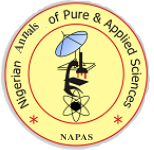Assessment of Heavy Metal Bioaccumulation Capacity of Calopogonium muconoides and Senna obtusifolia as Potential Bioremediation Agents
DOI:
Keywords:
Phytoremediation, Bioaccumulation, Heavy metals, Bioremediation, Senna obtusifolia, Calopogonium MuconoidesAbstract
A wide range of inorganic and organic compounds such as combustibles, and putrescible substances, hazardous waste, explosives, petroleum products and heavy metals (HM) can cause contamination. In addition, the non-biodegradability of heavy metals further exacerbates environmental pollution with its attendant health consequences on the biotic components of the ecosystem including humans. The use of living organisms such as plants and microbes is increasingly becoming acceptable practice of sustainable environmental sanitation. However, identification of potential bioremediation agents is still challenging. This study was carried out to bridge this gap by assessing heavy metal bioaccumulation properties of Calopogoniun Muconoides and Senna obtusifolia plants at contaminated site of mechanic workshop (site 1) in comparative to a physically non-contaminated site (site 2) within Makurdi metropolis of Benue State Nigeria. The selected plants were obtained from both sites and evaluated for their bioaccumulation capacities using standard procedures. The results revealed the sample plants accumulated high levels of heavy metals particularly in the leaves and roots, suggesting the utilization of phytoextraction, phytostabilization and phytovolatilization mechanisms of remediation. The plants and HM generally presented an order of concentration and bioaccumulation as: Senna obtusifolia > Calopogonium Muconoides; Zn > Fe > Pb > Cu > Cd > Cr > Ni. These findings suggest that these novel plants, especially Senna obtusifolia are good agents of bioremediation of heavy metals. Studies involving isotopic labeling to determine the exact mechanism of remediation as well molecular techniques such as transcriptomics and proteomics to identify genes/molecules that confer phytoremediation potential on the plants would be the next focus of our research in this emerging field of environmental biochemistry.
Downloads
Published
How to Cite
Issue
Section
License
Copyright (c) 2021 O Ogo, S Agbara, B Inalegwu, IW Nyinoh

This work is licensed under a Creative Commons Attribution-ShareAlike 4.0 International License.



 Contact Us
Contact Us Editorial Team
Editorial Team Join As A Reviewer
Join As A Reviewer  Request For Print Copy
Request For Print Copy


 Cprint Publishers
Cprint Publishers